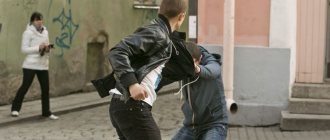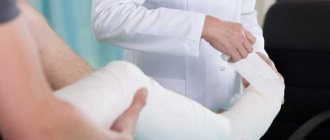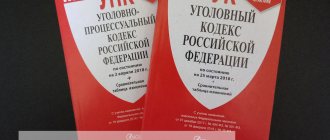Necessary defense is the inalienable right of any person, aimed at protecting oneself, legitimate interests, values and other benefits. Necessary defense is a deterrent to crime: the likelihood of a harsh response from the victim sometimes stops the attacker even better than possible punishment. This right is enshrined in Article 45 of the Constitution of the Russian Federation, which states that every person has the right to protect his rights and freedoms by all means not prohibited by law. The Criminal Code of the Russian Federation clarifies this provision in Article 37: it establishes the right to cause harm to an individual who encroaches on legally protected values.
However, often a person goes beyond the limits of necessary defense. In this case, Article 114 of the Criminal Code of the Russian Federation can be applied to the victim himself, the full name of which is as follows: “Infliction of grievous or moderate harm to health by exceeding the limits of necessary defense or by exceeding the measures necessary to detain the person who committed the crime.” According to the Judicial Department under the Armed Forces of the Russian Federation, in 2022, 505 people were brought to criminal liability under this article.
Let's consider the corpus delicti provided for in Part 1 of Article 114 of the Criminal Code of the Russian Federation
- Object: health of the victim.
- Objective side: causing harm to the health of the attacker, committed when the necessary limits of self-defense were exceeded. The criteria for determining the severity of harm are set out in Decree of the Government of the Russian Federation of August 17, 2007 No. 522: for example, loss of vision, speech, organ, termination of pregnancy, etc. will be considered such harm. To qualify under this part, there must be a clear discrepancy between the protection and the nature and degree of public danger of the act. For example, if a citizen tried to rob the victim, and the latter beat him and made him disabled, then there is an excess of the limits of necessary defense.
- Subject: a sane individual who has reached the age of 16.
- Subjective side: intentional form of guilt (direct or indirect intent). This crime is characterized by a special motive: protection from a socially dangerous attack or its suppression.
Part 2 of Article 114 of the Criminal Code of the Russian Federation establishes liability for causing moderate and grave harm to the health of the attacker by exceeding the measures necessary to detain a person.
On the application of this article, Resolution No. 19 of the Plenum of the Supreme Court of the Russian Federation was issued on September 27, 2012. In particular, paragraph 13 states that the court, when considering a case initiated under Article 114 of the Criminal Code of the Russian Federation, must pay attention to the following factors:
- object of encroachment;
- the method chosen by the attacker to achieve a criminal result, the likely consequences and the objective necessity of causing harm to the health of the attacker;
- time, place of attack, presence of surprise factor, number of attackers, presence of weapons;
- the victim's ability to repel the attack;
- other circumstances.
There are other nuances in the application of this article. For example, a person is not held criminally liable under Article 114 of the Criminal Code of the Russian Federation if the victim acted within reason when causing harm. In addition, liability also does not arise if, due to the factor of surprise, the citizen did not have time to objectively assess the nature and degree of the danger threatening him.
“The act in question falls into the category of minor crimes. This is explained by their motive (desire for protection), purpose (suppression of the act), and also by the fact that these crimes are largely forced in nature and committed under the influence of fear.”
Conditions for the admissibility of self-defense
Important information!
In case of a threat from your husband, neighbors or a stranger on the street, you should maintain presence of mind and not panic. In the event of violent acts, panic can develop into a state of passion and then the consequences will be irreversible. In this article we will tell you what to do in the event of a threat of physical harm.
In order to avoid abuse of self-defense measures, the legislation provides for criminal liability for exceeding their admissibility.
Obviously, the limits of admissibility can only be determined by the adequacy of protective measures to the actions of the attacking party. The more serious the threat to health and life, the stricter self-defense measures can be. For example, in response to a blow from an offender, defense with a knife or other weapon is unacceptable.
Exceeding the limits of necessary defense are situations in which the damage caused to the health and life of the attacker exceeds the danger of his attacks. For example, a citizen with a knife ran up to a passerby on the street and demanded money. The passer-by managed to knock out and intercept the knife from the attacker’s hands, then he used the same knife to stab the offender. There is an excess of permissible self-defense.
Conditions under which self-defense is considered permissible:
- lack of intentionality in protecting oneself from the offender;
- the presence of a real danger of harm to health, life or property. It does not matter in what form this danger exists at the moment: in the form of a threat or a completed action. For example, there is no need to wait until the attacker strikes his first blow, it is enough that he swings;
- the proportionality of the defense's response to the actions taken by the attacker;
- timeliness of self-defense actions, i.e. all measures taken within the framework of self-defense must be carried out from the moment the physical assault begins until the moment it ends, i.e. when the offender is potentially dangerous, but not when he is no longer able or unwilling harm your victim.
Punishment under Article 114 of the Criminal Code of the Russian Federation
Part 1 of Article 114 of the Criminal Code of the Russian Federation contains alternative sanctions:
- up to 1 year of repairs;
- up to 1 year of restriction of freedom;
- up to 1 year of forced labor;
- up to 1 year in prison.
As for Part 2, the sanctions are more stringent:
- up to 2 years of repairs;
- up to 2 years of restriction of freedom;
- up to 2 years of forced labor;
- up to 2 years in prison.
According to the Judicial Department under the Armed Forces of the Russian Federation, most often the justice authorities impose punishment under Article 114 of the Criminal Code of the Russian Federation in the form of compulsory labor (151 people), corrective labor (113 people) and suspended imprisonment (84 people). It is noteworthy that quite a lot of criminal cases are completed due to reconciliation with the victim: in 2018, 377 people were released from criminal liability for this reason.
Conditions for exemption from liability
Even if the limit of permissible measures in self-defense is exceeded, then if the actions that resulted in the death or serious injury of the attacker were carried out through negligence, the citizen is exempt from criminal prosecution. It is worth considering that in order to remove responsibility, a number of investigative actions are carried out aimed at accurately clarifying the chain of actions of all parties to the incident.
Death due to negligence is not classified by the Criminal Code of the Russian Federation as murder. The form of guilt here is inaction or unintentional actions. Article 109 of the Criminal Code of the Russian Federation provides for penalties for this crime in the form of imprisonment or forced labor. https://lexconsult.online/8228-prichinenie-smerti-po-neostorozhnosti
Let's consider here harm to health due to negligence
Let's give an example: a woman was attacked on the street by a man with the intention of taking her purse. The lady was not at a loss and pushed the attacker away. He slipped on the wet asphalt, fell, hit his head on the edge of the curb and died. It is obvious that such consequences of self-defense measures were not premeditated; the death of the attacker occurred due to a combination of circumstances. This was discovered during an investigative experiment, as a result of which no criminal case was initiated.
Let us consider several typical cases of exceeding the limits of necessary defense
Two sisters from Buryatia were drinking alcohol at home. Under the influence of alcohol, one of them began to express her complaints to her sister, then began to beat her, including with a chair. Trying to defend herself, the second woman stabbed her relative, causing her harm. Subsequently, the women reconciled, the accused provided financial assistance to the victim. As a result, the court found the woman guilty of committing a crime under Part 1 of Article 114 of the Criminal Code of the Russian Federation and gave her a suspended sentence of 8 months with a probationary period of 1.5 years.
And one more thing.
A resident of Kamchatka, defending herself and her children from violence from her husband, stabbed him in the chest. Initially, the court sentenced the woman to 8 months of suspended imprisonment under Part 1 of Article 114 of the Criminal Code of the Russian Federation, but the prosecutor’s office appealed this verdict. The higher authority took into account the positive characteristics of the convicted person, the low severity of the crime and the fact that she committed this unlawful act for the first time. As a result, the sentence was revised, and the woman was sentenced to restriction of freedom for a period of 7 months.
As we can see, the final punishment greatly depends on the judge’s personal perception of a particular situation. The problem is complicated by the fact that the institution of necessary defense has a lot of evaluative concepts, such as “obviousness”, “encroachment”, “compliance of protection with the nature and danger of the attack”, etc. A competent lawyer can build a line of defense in such a way that the judge will have no doubt about the citizen’s innocence in exceeding the limits of necessary self-defense.
A good result may also be a non-custodial sentence and a fine instead of punishment. However, the specific result will depend on the circumstances of the case and the level of professionalism of the lawyer providing legal assistance.
Not intentional grievous bodily harm, but exceeding the necessary defense
“Acting intentionally, L., with the aim of causing grievous harm to the health of H., dangerous to human life, realizing the social danger of his actions, foreseeing the inevitability of socially dangerous consequences in the form of causing grievous harm to the health of H. and desiring their occurrence, but together with however, not wanting to cause the death of X., although with due care and forethought he should have and could have foreseen the onset of X’s death, he deliberately struck one blow to the area of X’s right thigh with a knife found at the scene of the incident.”
.
The first thing that comes to mind after reading the above quote is the words of Viktor Chernomyrdin: “I can speak any language with everyone, but I try not to use this tool.”
1. Unfortunately, not everyone follows this rule...
But I read this only later, in the indictment, and on the night of the event, on a call from a person I didn’t know, I got ready and drove into a snowstorm to a village 30 km from Novosibirsk. The caller said that his brother had committed murder and he urgently needed a lawyer. As I was approaching the scene, I received another call and was forced to drive in the opposite direction as the suspect was taken from the crime scene to the police station.
As follows from the plot of the resolution to bring L. as an accused under Part 4 of Art. 111 of the Criminal Code of the Russian Federation, while drinking alcohol, a quarrel occurred between him and Kh., during which L., on the basis of a sudden personal hostility, arose a criminal intent aimed at deliberately inflicting grievous harm to his drinking companion, which negligently resulted in the death of the victim.
The difficulty of the defense in this category of cases is that in the absence of witnesses who could express their attitude to what happened, the only means available for reconstructing events is the flash memory of the defendant, who was in a state of heavy alcoholic intoxication. That is, the defense attorney, in fact, has nothing, while the investigator has only a corpse, a blood-stained room, a knife in the corpse’s leg, and a suspect who literally says: “Yes, I killed him.” As modern practice shows, any objections of a sobered defendant in such a reality will be reflected in the verdict with the court’s remarks: “Trying to avoid criminal liability for the crime committed...”.
From the defendant’s testimony it followed that in the process of drinking alcohol together with X., he called him a rooster. Having no formal criminal record, but having previously visited “places with pronounced coolness” three times, L. tried to explain to his interlocutor that the word “rooster” there, although it is heard more often than on poultry farms, has a completely different meaning, and asked for this word according to do not use it in relation to him anymore. Since this philosophy turned out to be alien to X., he objected in the most accessible, in his opinion, way - by hitting his interlocutor on the head with his fist at least twice. L. pushed the offender away. Then Kh. grabbed a kitchen knife from the table and rushed at L. My client knocked the knife out of Kh.’s hand, but he again attacked him with his fists. Tired of this tiresome “conversation,” L. grabbed a knife from the table that had fallen from X.’s hand and plunged it into his leg up to the hilt. Kh. fell to the floor and died a few minutes later from hemorrhagic shock - the knife blade cut the femoral artery. Immediately after this, L. called his wife and asked to call the police and an ambulance.
After listening to this story from my client, I immediately submitted a request to the investigator to order a forensic medical examination, raising the question of the nature and time of the injuries on L’s head. In addition, understanding that the defense’s position is based solely on the testimony of the suspect, I filed a request to interrogate the doctor doctor L. at the district clinic - they needed an answer to the question about whether the defendant had diseases associated with impaired motor functions. Having found out from the principal which of his fellow villagers could confirm the version that L.’s leg functions were impaired while intoxicated, I submitted a request to question witnesses as part of the preliminary investigation.
During the interrogation, L. testified that he suffered from a neurological disease, due to which his movements were limited; this did not allow him to jump out of his chair and avoid the blows that X inflicted on him. It turned out that in the absence of witnesses, for the same reason, L. could not escape from the crime scene! I thought for a long time whether to use such an argument. On the one hand, this fact confirms the helpless state of the defendant, who could neither escape nor effectively defend himself from the attacker. On the other hand, formally, in this way I stated that under other circumstances L. would certainly have run away, trying to lead the investigation to a dead end and “cover his tracks.” Of course, I would not have meant that, but the prosecution could very likely interpret my arguments that way. And yet I took a risk...
At the court hearing, I explained that my client really perceived the threat to life and health posed by X., since he had already struck him several blows to the head, causing fear and pain. To avoid life-threatening consequences, at the time of the next attack, the defendant grabbed a knife that had fallen from X. from the table and, stopping his criminal intentions, delivered a single blow to the safest place, in his opinion, in the leg just above the knee. He had the opportunity to stab H. in the chest, stomach, groin and neck, since he was standing directly above him, but did not want to kill him or cause grievous bodily harm, but simply wanted to stop the attacker’s illegal actions.
Immediately after the interrogation of the defendant, a petition was filed to reclassify the act incriminated to him from Part 4 of Art. 111 on part 1 of Art. 114 CC. Despite the apparent possibility of filing a motion to terminate the criminal case due to L. being in a state of necessary defense, I considered this unacceptable due to the presence of circumstances, the refutation of which in the future could become disastrous for the chosen position. There was other evidence indicating that L. was not in a state of necessary defense. Indirect, “slippery”, they had not yet appeared in the materials of the criminal case, but I was sure that this was a matter of time. It’s like a pen slowly rolling towards the edge of a table – will it fall or not? As it turned out later, I was right in this too - the indicated circumstances appeared in the materials of the criminal case as an image on photographic paper, but it was too late, since the prosecution could not refute the position chosen by the defense.
When carrying out defense in this category of cases, the key is Resolution of the Plenum of the Supreme Court of the Russian Federation dated September 27, 2012 No. 19 “On the application by courts of legislation on necessary defense and causing harm when detaining a person who has committed a crime,” which clearly sets out the procedure for bringing to criminal liability and reclassification of the crime from Part 4 of Art. 111 on part 1 of Art. 114 CC. Despite the fact that the main part of the resolution is devoted to the interpretation of Art. 37 of the Criminal Code, it also explains the grounds for requalification. This resolution provided me with invaluable assistance both in challenging the charges at the stage of the judicial investigation and in preparing my defense speech.
During the preliminary investigation, I submitted requests for reclassification of the act twice more, all of which were denied by the investigator. However, each of the petitions contained new grounds for his statement, and as a result, these petitions, as well as the investigator’s unclear answers to them, became part of the criminal case, undermining the “framework” of the accusation.
In order to undermine the position of the state prosecutor who supported the charge against L. under Part 4 of Art. 111 of the Criminal Code in full, the facts directly examined in the court session were needed.
Thus, witness S. testified in court that he is the attending physician of L., who suffers from a disease in which the motor functions of the lower extremities are impaired. Alcohol aggravates the symptoms of the disease, negatively affecting motor functions. The doctor confirmed that L. could not walk while intoxicated and asked his relatives to take him home. His testimony confirmed the testimony of my client in that at the time of X.’s attack he could not run away and effectively defend himself, including from punches.
At my request, a re-examination of X’s corpse was ordered. This time, the specialist was asked questions about the location of X. and L. relative to each other at the time of the incident. In conclusion, the expert came to the conclusion that the distance between the accused and the victim corresponded to that pointed out by L. At the same time, he did not rule out that L. struck with a knife at the moment when he was sitting in front of Kh. standing in front of him - that is, he was occupying vulnerable position.
An investigative experiment conducted at the court hearing with the participation of an extra and a reconstructed situation with the use of a knife refuted the prosecution’s version that the defendant was preparing to commit a crime, and confirmed the defense’s version of the place where the knife fell after the defendant knocked it out of the victim’s hand, and not “looked for”, as the investigation claimed, to commit a crime.
It also followed from the forensic expert’s report that L. had a bruise in the right cheek-zygomatic region, which formed during the period corresponding to the time of the incident. This confirmed the defense version that the victim hit the accused on the head. My client’s testimony was supported by an extract from a medical institution dated February 10, 2022, which indicated the diagnosis: “Dorsopathy of the lumbar spine.” Additionally, the certificate I requested from the outpatient clinic dated February 25, 2022, containing information about L.’s specific disease, became new evidence. Witnesses for the defense, questioned at the preliminary investigation stage, confirmed at the trial that the victim was aggressive and an unpredictable bully.
Sister Kh., recognized as a victim, at the court hearing asked for the most severe punishment for the defendant. The prosecutor, in turn, asked the court to recognize L.'s state of alcoholic intoxication at the time of the crime as an aggravating circumstance and impose a sentence of imprisonment for a period of 10 years.
During the meeting, I repeatedly and consistently convinced the court that the criminal prosecution body had opened a criminal case under Part 4 of Art. 111 of the Criminal Code and L. was brought as an accused solely on the basis that the outcome of the event was, as determined by a forensic examination, serious harm to the victim’s health, resulting in death. I am sure that the court was also greatly influenced by my use as an argument of the fact that the involvement of L. as an accused for committing a crime under Part 4 of Art. 111 of the Criminal Code was carried out without taking into account the requirements of the Resolution of the Plenum of the Supreme Court of September 27, 2012 No. 19 and generally accepted judicial practice. For almost six months, I convinced the court that the evidence collected in the case allows us to declare that the position of the criminal prosecution body was erroneous, and the factual circumstances of the case and the totality of evidence indicate the need to reclassify the act under Part 1 of Art. 114 CC.
As a result, the court did not find in the actions of the defendant the guilt indicated in the indictment, indicating that the position of the prosecution was not supported by the case materials and evidence examined at the hearing, as well as the fact that the state of intoxication influenced or could influence the commission of the crime. By the verdict of the Novosibirsk District Court of Novosibirsk dated March 30, 2022, L. was found guilty under Part 1 of Art. 114 of the Criminal Code and sentenced to 11 months of correctional labor. At the same time, the court counted the convict’s stay in the pre-trial detention center from the moment of detention into the sentence, and therefore decided that the sentence had been served and released L. in the courtroom.
In conclusion, I note that the chances of a favorable outcome increase when the defense is reduced not to refuting the prosecution’s arguments, but to forcing the prosecution to refute the defense’s arguments. This, as practice has shown, is the weakest link in the chain of actions of the investigator and prosecutor.
1 Magazine "Itogi". 1996. No. 26.
Examples from judicial practice
Example one: robbers armed with pistols tried to break into the house of I.’s family. Head of the family gr. I., after the attackers shot at the door, took his hunting rifle and fired twice through the door towards the robbers. The criminals did not expect resistance, so they did not hide. As a result, one of the robbers was killed and the other was wounded. The neighbors called the police. After the investigative proceedings, self-defense measures were found to be justified and Mr. I. was not prosecuted.
Example two: late in the evening on the street to gr. A. got attached to the drunken gr. P. demanding to give up money and phone. At the same time, he waved a baseball bat and used obscene language about the gr.’s appearance. A. Having flared up, gr. A. struck the drunken brawler, knocked him down and began to strike him numerous times. He stopped the beating only after the intervention of passers-by. Without regaining consciousness, Mr. P. died. Against gr. A. a criminal case was initiated under Art. 108.1 and a penalty of imprisonment for 2 years was applied.
A specialist will answer your questions in the comments to the article






